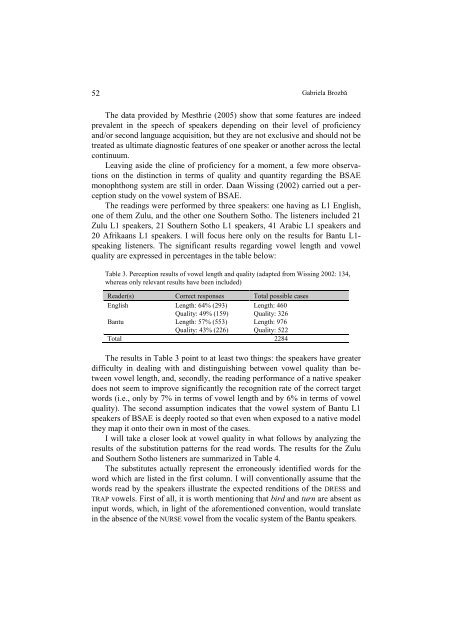s - Wyższa SzkoÅa Filologiczna we WrocÅawiu
s - Wyższa SzkoÅa Filologiczna we WrocÅawiu
s - Wyższa SzkoÅa Filologiczna we WrocÅawiu
You also want an ePaper? Increase the reach of your titles
YUMPU automatically turns print PDFs into web optimized ePapers that Google loves.
52<br />
Gabriela Brozbă<br />
The data provided by Mesthrie (2005) show that some features are indeed<br />
prevalent in the speech of speakers depending on their level of proficiency<br />
and/or second language acquisition, but they are not exclusive and should not be<br />
treated as ultimate diagnostic features of one speaker or another across the lectal<br />
continuum.<br />
Leaving aside the cline of proficiency for a moment, a few more observations<br />
on the distinction in terms of quality and quantity regarding the BSAE<br />
monophthong system are still in order. Daan Wissing (2002) carried out a perception<br />
study on the vo<strong>we</strong>l system of BSAE.<br />
The readings <strong>we</strong>re performed by three speakers: one having as L1 English,<br />
one of them Zulu, and the other one Southern Sotho. The listeners included 21<br />
Zulu L1 speakers, 21 Southern Sotho L1 speakers, 41 Arabic L1 speakers and<br />
20 Afrikaans L1 speakers. I will focus here only on the results for Bantu L1-<br />
speaking listeners. The significant results regarding vo<strong>we</strong>l length and vo<strong>we</strong>l<br />
quality are expressed in percentages in the table below:<br />
Table 3. Perception results of vo<strong>we</strong>l length and quality (adapted from Wissing 2002: 134,<br />
whereas only relevant results have been included)<br />
Reader(s) Correct responses Total possible cases<br />
English<br />
Length: 64% (293) Length: 460<br />
Quality: 49% (159) Quality: 326<br />
Bantu<br />
Length: 57% (553) Length: 976<br />
Quality: 43% (226) Quality: 522<br />
Total 2284<br />
The results in Table 3 point to at least two things: the speakers have greater<br />
difficulty in dealing with and distinguishing bet<strong>we</strong>en vo<strong>we</strong>l quality than bet<strong>we</strong>en<br />
vo<strong>we</strong>l length, and, secondly, the reading performance of a native speaker<br />
does not seem to improve significantly the recognition rate of the correct target<br />
words (i.e., only by 7% in terms of vo<strong>we</strong>l length and by 6% in terms of vo<strong>we</strong>l<br />
quality). The second assumption indicates that the vo<strong>we</strong>l system of Bantu L1<br />
speakers of BSAE is deeply rooted so that even when exposed to a native model<br />
they map it onto their own in most of the cases.<br />
I will take a closer look at vo<strong>we</strong>l quality in what follows by analyzing the<br />
results of the substitution patterns for the read words. The results for the Zulu<br />
and Southern Sotho listeners are summarized in Table 4.<br />
The substitutes actually represent the erroneously identified words for the<br />
word which are listed in the first column. I will conventionally assume that the<br />
words read by the speakers illustrate the expected renditions of the DRESS and<br />
TRAP vo<strong>we</strong>ls. First of all, it is worth mentioning that bird and turn are absent as<br />
input words, which, in light of the aforementioned convention, would translate<br />
in the absence of the NURSE vo<strong>we</strong>l from the vocalic system of the Bantu speakers.
















